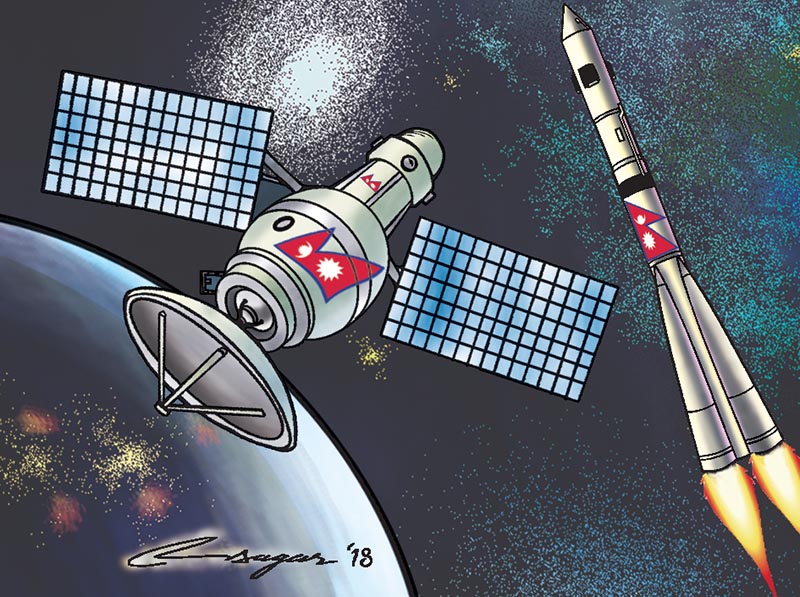Digital leapfrogging: Can Nepal achieve it?
A country’s economic growth is tied to its telecommunication networks. Can Nepal launch her own satellite to secure connectivity and economic prosperity for its citizens? It can. But to secure the growth, we have to seize the opportunity that we have before us
On August 3, 2018, Prime Minister KP Oli opened his speech at the Digital Nepal Conference with the anecdotal story of the Gazelle and Lion.
“Every morning in Africa, a gazelle wakes up. It knows it must run faster than the fastest lion or it will be killed. Every morning a lion wakes up. It knows it must outrun the slowest gazelle or it will starve to death.”
The story is a meaningful metaphor for Nepal’s standing in today’s digital world.
Nepal has surely fallen behind. For the last two decades, there has been little to no economic growth. As of 2018, the International Telecommunications Union (ITU) reports that Nepal’s broadband connectivity is less than 20 per cent. Our peers, the landlocked nations like Bhutan, Laos and Afghanistan, as well as Sri Lanka and Pakistan—two nations affected by armed conflict and terrorism—have leapfrogged and are ahead of us. They have become the proverbial gazelles, outrunning even their fastest competitors. However, there is hope for Nepal—a silver lining is within our sight.
Geostationary slots (also called orbital slots) are limited and rare resources granted by the International Telecommunications Union (ITU) for equitable broadband access using satellite technology. Nations worldwide are entitled to orbital slots with specific frequencies based on the country’s developmental needs and geographic considerations.
During the Sputnik days of the 70s and 80s, satellite was considered to be a privilege available to a select few wealthy nations. However, in recent years, satellite technology has become much more viable. Major breakthroughs have significantly improved their use in telecommunications while reducing the costs to construct and maintain such services. As a prime example, Elon Musk’s SpaceX programme has roughly halved the cost to launch a satellite.
Two space orbital slots at 50E and 123.3E were granted to Nepal by the ITU in 1984. However, we have failed to bring them to use. While these slots and the associated frequencies are allocated to Nepal indefinitely, satellites launched by other nations and private entities into neighbouring slots weaken the potential performance of future Nepali satellites.
This risk poses a threat to Nepal’s digital sovereignty and telecommunications infrastructure which we cannot afford to lose if we want to leap forward along with our peers.
Nepal has a unique but time-bound opportunity.
Where our other telecommunications, such as optic fibre and microwave can take significant time to deploy and have to contend with Nepal’s topography, a satellite is a ready-to-go digital infrastructure which can have a significant and immediate impact on every segment of our society—governance, education, healthcare, tourism, agriculture natural disasters.
Our peer nations in South Asia have not been sitting idle in the face of this opportunity. Sri Lanka and Bangladesh have already launched their own communications satellites—their respective Supreme SAT-I satellite on November 27, 2012, and Bangabandhu-1 satellite on May 11, 2018.
In the recent 73rd United Nations General Assembly last month, PM Oli stated, “Nepal’s recent political transformation is about making Nepali people truly sovereign and as a source of state power”.
Yet how can Nepal become digitally sovereign when our only access points for connectivity are from India and China? We need connectivity that is undisrupted, independent and autonomous. And the only way we can guarantee this is through satellite technology.
Of course, the big elephant in the room is “can we afford it?” The short answer is: Yes, we can.
A World Bank research reveals that every 10 percentage point increase in broadband penetration increases gross domestic product growth by 1.38 per cent in developing countries. Today, many countries are looking for policies that will stimulate growth and create new jobs.
Digital development can contribute to direct job creation. The information and technology sector one of the largest employers globally and it is expected to remain so. Digital transformation can also result in the emergence of new services and industries. This will give rise to business innovation. The internet can provide businesses with new ways of reaching out to customers and competing for market share.
Much of the world today is reaping digital dividends. As companies benefit through economic growth, people also benefit as there are new jobs. Digital transformation can enable governments to deliver better services, thereby resulting in content citizens who can, in turn, contribute back to society.
A country’s economic growth is thus tied to its telecommunication networks. But in order to secure this growth, we have to stop playing the blame game—whether it is politics, economic policies, natural disasters-led setbacks—and move ahead of the pack to build a connected Nepal. If we as a nation do not take advantage of this opportunity hanging over our heads, we’ll become the lion that starves in digital darkness.
Koirala, a graduate from University of Maryland, College Park, is a technology entrepreneur






